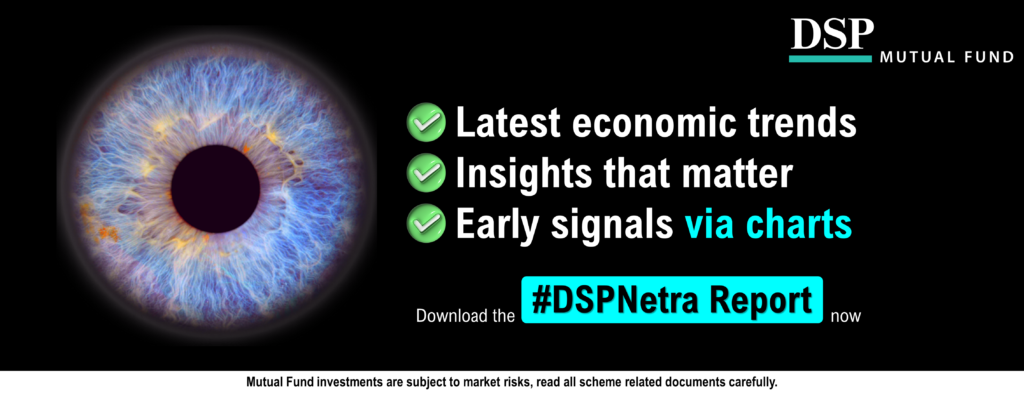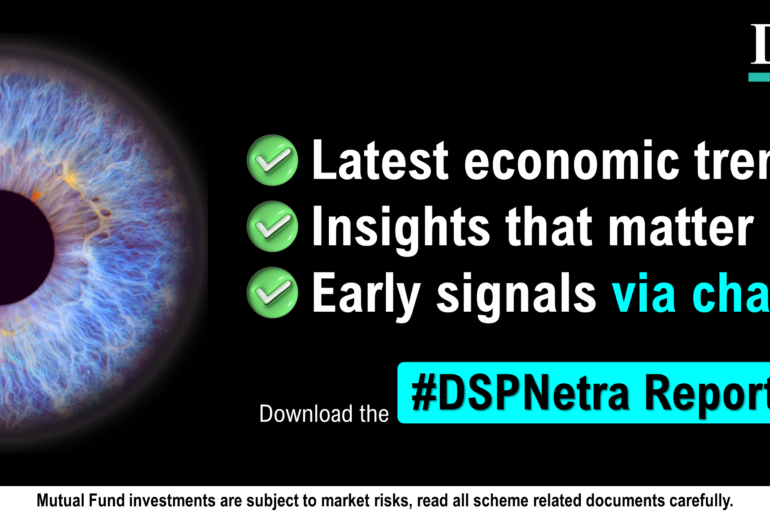Last Updated on Nov 21, 2023 by Anjali Chourasiya
The November 2023 edition of Netra is here, offering insights on the performance of a few key cyclical indicators in the US market, what they mean for the US economy, the domino effects on the Indian markets and how you can navigate the choppy waters of the global economy.
Importantly, the report highlights the decline in non-revolving credit in the US as a sign of weakening economic resilience with potential global implications. The report then explores the overvaluation signals in the S&P 500 index. Netra – November also probes the implications of high valuations in the Indian markets and the anticipation of earnings growth, diving into the delicate balance between optimism, PE ratios, and sustainable returns.
Table of Contents
Credit offtake signals caution for the US economy
The United States is currently facing challenges in the form of a declining trend in non-revolving credit that casts a shadow of caution over the country’s economic prospects. Non-revolving credit refers to loans with fixed terms and regular repayment schedules, such as instalment loans for big-ticket items like cars and education.
This metric is experiencing a year-on-year contraction in the US. This indicates that consumers are borrowing less and reducing spending on purchases such as cars and education.
The decline in consumer consumption is a cause for concern as it plays a pivotal role in driving the US economy. However, this may be attributed to limited purchasing power, economic slowdown, and a visible change in spending patterns brought about by the surging interest rates in the US.
One of the pressing questions on economists’ minds is how the US economy can maintain its momentum henceforth. Particularly on home loans and auto loans, interest rate levels exceed 8% presently. As you may be aware, the demand for housing, automobiles, and other durable goods is notably sensitive to interest rates, and the current multi-decade high in interest rates is causing apprehension.
History reveals an alarming data point and a striking pattern: a decline in non-revolving credit has often preceded US recessions since 1960. While it’s not a definitive indicator of a recession, it is one of the contributing factors that can lead to economic slowdown. It serves as a warning sign for US economic growth and the global economy, with the US playing a central role in the world’s financial stability.
S&P 500 Index – Valuation journal
The S&P 500 index appears overvalued on multiple parameters. As a barometer of the largest publicly traded US companies, the S&P 500 is considered a bellwether of the overall health and valuation of the US stock market. Currently, the key valuation metrics that analysts routinely use to ascertain the fair intrinsic value of the S&P 500 indicate it is trading above its fair value. Namely, parameters such as the Cyclically Adjusted Price-to-Earnings (CAPE) ratio and dividend yield point to the index hovering at notably lofty heights, commanding a sizable valuation premium. This raises red flags and may indicate that a correction is in order in the future.
The rise in yields on US Treasury securities in recent months may also be signalling the same. The spike in yields conveys that fixed-income markets have become comparatively more attractive to investors seeking refuge from stock volatility and for its adjusted return potential. Higher yields implicitly lower the present value of future cash flows from bonds, rendering them cheaper on a relative basis. The rotation into perceived safe-haven government debt indicates growing caution regarding risk assets such as equities.
Additionally, while Price-to-Earnings (PE) multiples for S&P 500 firms have normalised somewhat from their extreme pandemic peaks, the forward PE ratio currently hovers around the 25 yr average. This indicates that while valuations are only modestly overstretched, stocks may still face headwinds unless earnings power materially accelerates in the coming quarters to validate these valuation premiums.
What would you pay for earnings growth?
Over the past decade, India has delivered excellent returns. A nominal GDP growth of 10.9% (as per CSO data) is commendable against a backdrop of a calamity-stricken world and post-COVID recovery. A significant factor driving these returns has been the narrative around the India growth story and the confidence of investors about the long-term potential of Indian businesses. This optimism has been reflected through the upward re-rating of valuation multiples of companies.
While earnings per share has grown about 8% in the past 11 yrs, the market cap of Indian companies has grown 13%. Meantime, the Nifty index has returned 12.5% on a compounded annual basis.
However, in the face of declining consumer demand as a delayed impact of high-interest rates (we’ve seen how credit offtake stands affected), sales growth will likely decline. This may then affect profitability, which can lead to a de-rating across equity markets.
Now, should the Nifty dip down to below 18,000 levels (from the 19,500-odd levels it hovers around at the time of writing this article), the burning question is: would investors still be willing to pay a very large premium?
While a double-digit earnings growth rate seems attractive, a PE of 22x leaves little margin of safety. Any miss of earnings estimates or slowdown in growth could lead to significant downward pressure on the stock price as valuations contract.
History reveals periods of exceptional valuation multiple expansion is rarely sustainable. High beginning valuations tend to coincide with lower future returns. After such a prolonged rally in Indian equities supported by upward re-ratings, any forthcoming returns will need to be fueled predominantly by actual earnings growth achievement rather than forward-looking valuation expansions. The market may be primed for a correction if earnings do not meet the elevated expectations.
The impact on the Indian economy
From an Indian perspective, parallels can be drawn between certain observations made for the United States and the Indian scenario. Notably, the phenomenon of consumption slowdown resonates in India, particularly within the value (i.e., lower-priced) segment, where retailers have experienced a deceleration in sales. However, a ray of optimism emerges during the festive season, when demand surpasses expectations.
The alignment with the assessment of valuations is undeniable. Admittedly, Indian markets are currently trading at elevated valuations, acknowledging one facet of the situation. On the flip side, the concept of investability becomes paramount. In the midst of significant geopolitical uncertainties, India emerges as a well-positioned destination.
An impartial analysis suggests that the Indian markets appear poised for resilience, notwithstanding the prevailing valuations. It is imperative to recognise the criticality of sector selection in the current scenario. The divergence between returns and capital allocation across various market sectors is noteworthy. While the inclination is often to favour the recent best performer, it is prudent to consider that alpha may also be derived from sectors that have been overlooked.
Furthermore, as investors pay higher premiums for companies, pushing valuations further, the potential to achieve returns beyond the average diminishes. Therefore, the advised strategy is to diversify one’s investment portfolio across various asset classes, promoting a multi-asset approach.
The bottom line
In the US, consumer demand stands affected as the impact of high interest rates plays out. This is causing people to borrow less as fixed payment loans towards items like cars and education. This dip could potentially impact the US economy with a domino effect on the global economy. The stock market in the US also seems a bit expensive on the valuation front, and investors might be turning to safer securities such as government treasury and bonds. In India, high confidence in the future of businesses might not last, and the stock market that is currently overvalued and trading at a premium could see a normalisation. The Netra report analyses these economic changes and informs investors to enable them to make smarter decisions in uncertain times. Check out the full report for all the details.
Disclaimer
In this material DSP Asset Managers Pvt. Ltd. (the AMC) has used information that is publicly available, including information developed in-house. Information gathered and used in this material is believed to be from reliable sources. While utmost care has been exercised while preparing this document, the AMC nor any person connected does not warrant the completeness or accuracy of the information and disclaims all liabilities, losses and damages arising out of the use of this information. The recipient(s) before acting on any information herein should make his/their own investigation and seek appropriate professional advice. The statements contained herein may include statements of future expectations and other forward looking statements that are based on prevailing market conditions / various other factors and involve known and unknown risks and uncertainties that could cause actual results, performance or events to differ materially from those expressed or implied in such statements. The sector(s)/stock(s)/issuer(s) mentioned in this presentation do not constitute any research report/recommendation of the same and the schemes of DSP mutual fund may or may not have any future position in these sector(s)/stock(s)/issuer(s). All opinions/ figures/ charts/ graphs are as on date of publishing (or as at mentioned date) and are subject to change without notice. Any logos used may be trademarks™ or registered® trademarks of their respective holders, our usage does not imply any affiliation with or endorsement by them. These figures pertain to performance of the index/Model and do not in any manner indicate the returns/performance of the Scheme. It is not possible to invest directly in an index. All data source is Internal unless specifically mentioned, and is up to Jul 31, 2023
Past performance may or may not be sustained in future and should not be used as a basis for comparison with other investments.



